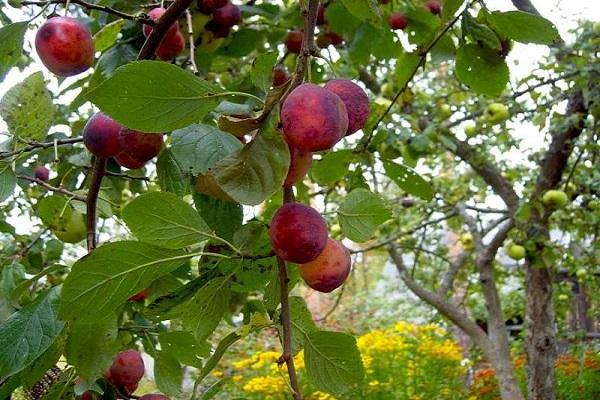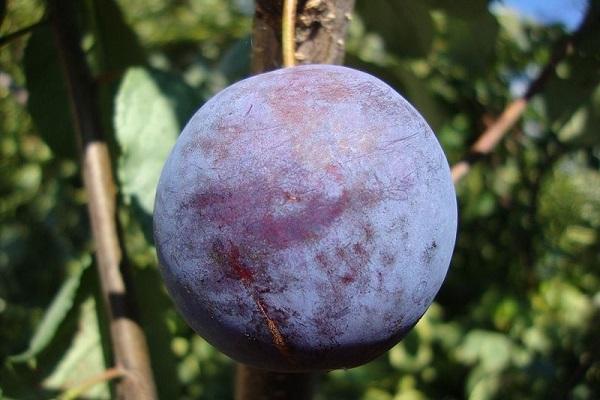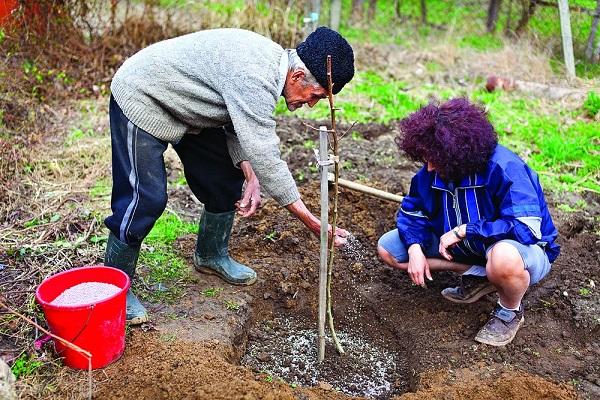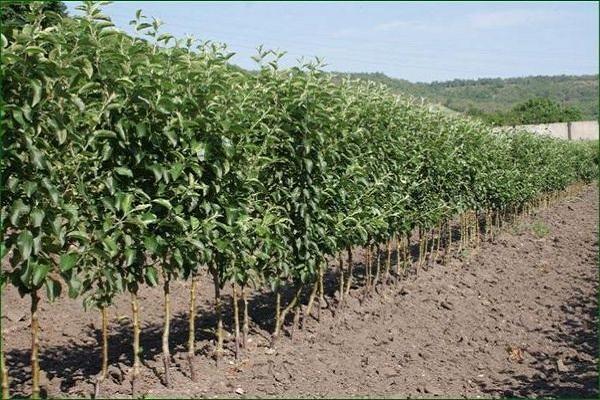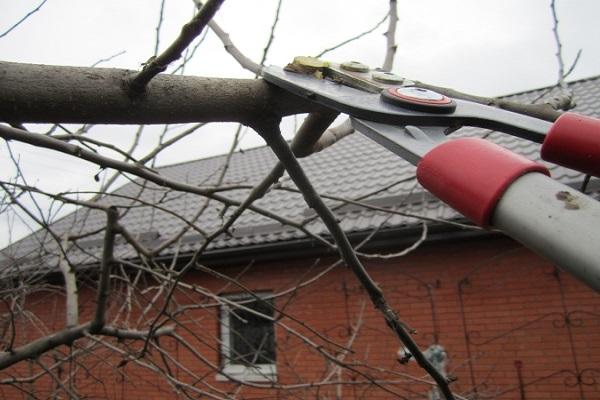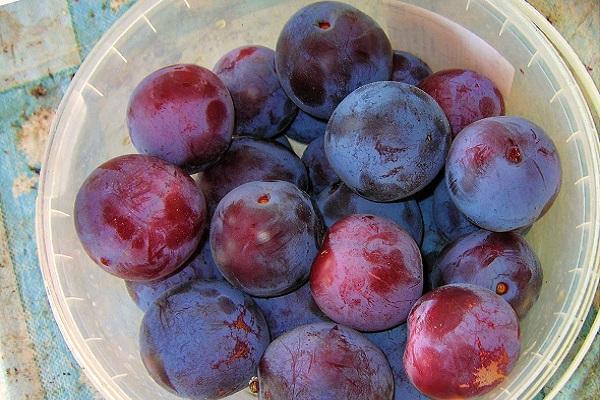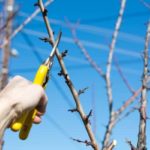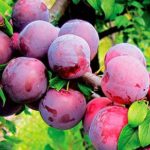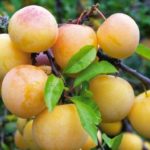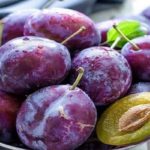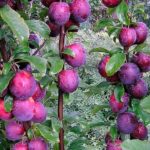The plum variety Etude has excellent product and taste characteristics of the fruit. Their tasting rating, transportability, and keeping quality are considered its main advantages. The variety is known among gardeners as one of the most productive. Therefore, it can be increasingly seen in gardens and summer cottages.
Plum Etude: description and characteristics of the variety
Table technical plum variety of the mid-early ripening period. Etude was obtained by crossing a hybrid of the Eurasia 21 culture and the Volzhskaya Krasvitsa plum. Author G. A. Kursakov. The plum tree begins to bear fruit 3-4 years after the seedling is planted. Pleases with abundant, beautiful flowering in the last ten days of May. The fruits ripen in mid-August.
Tree and foliage
The plum variety Etude is a tall tree that forms a raised oval-spherical crown. The plant is covered with rough bark that has a dark brown tint with a grayish coating. The leaves are large, circular in shape, have an oval base and a slightly pointed tip, sharply turning into a nose. The leaf blade is distinguished by a dark green color and slight wrinkles.
Fruit
The variety is valued for its fruits, weighing up to 30 g, oval-ovoid in shape. When technically ripe, the fruit is colored green, and when fully ripe it acquires a bright purple color. The peel is characterized by density with the presence of a waxy coating. The pulp has an emerald-amber tone, very juicy with a sweet taste and slightly noticeable sourness. The stone is oval-shaped, small in size, and easily comes away from the pulp.
The harvest is good not only for fresh consumption, but is also used for making homemade winter preparations such as jam, preserves, and compote.
Productivity
From year to year the crop consistently produces fruits. The harvest is harvested in the last ten days of August. One tree can produce up to 20 kg of fruit.
Advantages and disadvantages
The plum variety Etude is endowed with a number of advantages, thanks to which it is in particular demand among summer residents:
- precociousness;
- winter hardiness, drought resistance;
- immunity to major diseases characteristic of the culture;
- high productivity;
- excellent taste, tasting score is 4.3 points;
- presentation of the fruit;
- transportability, which makes it possible to grow crops for industrial use;
- keeping quality, allowing plums to be stored for about 2 months;
- versatility of purpose.
No deficiencies have been identified in the variety. The only drawback is considered to be self-sterility, so the Etude plum variety needs pollinators, which can be Renclod Tambovsky and Volga Beauty.
Cultivation
Like every fruit tree, the Etude plum has its own terms and requirements for planting, which are important to take into account, since a small error can leave you without the plant itself, as well as the desired harvest.
Time and place for landing
When choosing a seat, you need to consider the following factors:
- illumination, if it is insufficient, the sugar content of fruits may decrease and the quality of the harvest may decrease;
- protection from winds and drafts;
- the terrain of the site should be flat, lowlands can flood the plant, which will lead to the death of the tree;
- light sandy loam soil with neutral acidity and moisture capacity.
It is recommended to plant the Etude plum variety in the fall, at the end of the growing season, 1-2 months before the onset of frost..
Seedling preparation
When choosing material for planting, you should pay attention to its appearance, which should not have signs of disease, as well as dry leaves or broken branches. It is better to use seedlings at the age of 2 years. Before planting, they must be treated with limestone mortar.
Landing technology
Proper planting of the Etude plum variety is a guarantee of the successful development and favorable existence of the plum tree, so the following procedure is required:
- Prepare the planting hole three weeks before the planned planting. In the designated location, dig a hole measuring 70 x 50 x 60 cm.
- At the bottom, form a hill from a soil mixture containing the top layer of soil, organic and mineral substances.
- Install a stake to securely support the young tree.
- Lower the seedling, carefully straightening the root system, and bury it, shaking the plant to distribute the soil between the roots.
- Cover with fertile soil, compacting thoroughly to avoid the formation of voids.
At the end of planting, water and mulch with peat.
Plant care
When cultivating the Etude plum variety, not only proper planting is important, but also subsequent care, which must be carried out in accordance with all the rules.
Watering
The crop needs to be watered regularly. 2 times a week is enough. In hot weather, increase the amount of irrigation up to 3 times. Each plant should receive 10 liters of water. It is not recommended to fill the soil during the rainy season.
Feeding
Saturate the plum tree of the Etude variety with all the necessary nutrients by adding a complex of fertilizers to ensure its healthy appearance and strong immunity. In the first year, the plant does not need fertilizing; in the second year, apply nitrogen-containing substances twice at the beginning and end of June.
Starting from the 3rd year of a tree’s life, fertilize it at the end of April with nitrogen elements, in June with nitrophoska, in August after picking the fruits, using phosphorus-potassium substances.
Trimmings
Spring and autumn are the time to carry out this agrotechnical technique.It is necessary to prune in the second year after planting the seedling. The crown of the Etude plum variety should be formed in the form of tiers. Lay 6-8 healthy strong branches as the basis. Also rid the plant of dry, damaged shoots.
Wintering
Although the Etude plum variety is characterized by frost resistance, at the initial stages of development in the presence of severe winters it needs shelter. They can serve as a cover of peat and fallen leaves. A snow mound placed in the area around the plant's trunk will protect the tree from frost in winter and supply the crop with moisture in early spring.
Diseases and pests
According to the description, the variety has good resistance to major diseases and dangerous pests. Therefore, there is no need for mandatory preventive spraying to protect the crop from fungi and infections.
Cleaning and storage
The Etude plum variety is harvested in mid-August. Fruits should be harvested when dry weather prevails. If they get caught in the rain, you need to let them dry a little.
Plums without mechanical damage should be placed in one row in boxes made of wood, lined with paper, and transferred to storage.
To preserve the healing properties, the room where the crop is kept should have a temperature of 0–2 °C and a humidity of at least 85%. Under such conditions, the shelf life of plums will be from 2 to 3 months.
To ensure that the quality and quantity of the harvest does not disappoint and pleases with the expected results, you need to choose the Etude plum variety, which has a special taste and a pleasant harmonious aroma.

